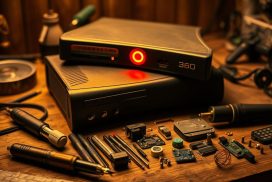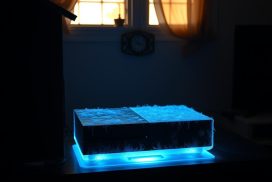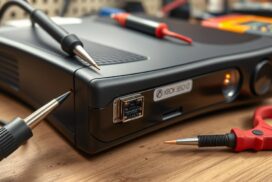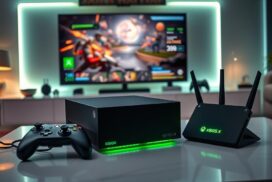Fixing Xbox 360 Connection Issues: A Step-by-Step Guide
Returning from a trip to find your gaming console refusing to connect can be frustrating. Many users face similar home network challenges after unplugging devices for extended periods. If your system worked perfectly before vacation but now shows error 8015190E, you’re not alone.
This specific connectivity problem often appears when routers like the Zyxel VMG1312-B10D need configuration adjustments. While other devices reconnect smoothly, the console might struggle with cached settings or outdated credentials.
Simple solutions exist for these post-power cycle disruptions. Router resets, profile refreshes, and cache clearing frequently resolve the issue. We’ll walk through these fixes and help restore your gaming experience quickly.
How to Fix Xbox 360 Connection Problems?
Network disruptions can trigger specific error codes like 8015190E. This usually points to MTU mismatches or NAT configuration issues. While frustrating, these errors often stem from router settings rather than hardware failures.
Decoding Error 8015190E
The error 8015190E appears when your console struggles with Maximum Transmission Unit (MTU) limits. Xbox Live requires MTU values between 1364-1492. Even if your router is set to 1458 (within range), slight mismatches can cause this problem.
Another culprit is NAT-T functionality. If your modem doesn’t properly enable NAT, Xbox Live connections may fail despite UPnP being active. Check if UDP port 3074 is open—it’s critical for traffic.
Local Network vs. Internet Access
Your console might connect to the local network but fail to reach the internet. This happens when the router allows internal communication but blocks external data packets. Verify DNS settings (like 8.8.8.8) and ensure ports 88, 3074, and 80 are forwarded correctly.
UPnP simplifies this, but some routers—like the TD-W8968—need manual tweaks. If tests pass locally but fail globally, focus on port configurations and firewall rules.
Basic Troubleshooting Steps
Physical connections and power cycles solve many network glitches effortlessly. Start with these foundational checks before exploring advanced settings.
Restart Your Router and Console
Unplug your router for 10 seconds to ensure capacitors discharge fully. Wait 5+ minutes before reconnecting. Then, hold the console’s power button for 10 seconds to force a shutdown.
Power cycling in this sequence often resolves cached credential errors. Always reboot the router first, followed by the console.
Check Ethernet and Wi-Fi Connections
A wired connection via Ethernet minimizes interference. Test stability by swapping to a cable temporarily. If issues persist, inspect cables for frays or loose plugs.
For Wi-Fi, compare signal strength in different locations. Wireless networks may drop packets due to distance or obstructions.
Pro Tip: Wired testing isolates whether the problem stems from the network connection or wireless interference.
Adjusting Router Settings for Xbox Live
Router settings often hold the key to resolving persistent connectivity issues. If basic troubleshooting fails, dive deeper into your network hardware configurations. Three critical adjustments—UPnP, MTU values, and port rules—can restore seamless gameplay.
Enable UPnP and NAT-T
Universal Plug and Play (UPnP) automates port management for gaming traffic. On Zyxel routers, navigate to Advanced > NAT > UPnP and toggle it on. Ensure NAT-T (Network Address Translation-Traversal) is compatible—older modems may block UDP traffic without it.
Note: UPnP simplifies connections but may pose security risks if left unmonitored. Regularly update your router firmware to patch vulnerabilities.
Optimize MTU Settings (1364–1492)
Xbox Live requires MTU values between 1364–1492. Even if your router defaults to 1458, slight mismatches can disrupt sessions. Test optimal values:
- Access your router’s admin panel (usually 192.168.1.1).
- Locate WAN > MTU and adjust incrementally.
- Save changes and reboot the console to test stability.
Port Forwarding for Xbox Live
Manual port rules ensure traffic prioritization. Forward these ports to your console’s static IP (e.g., 192.168.1.100):
| Port | Type | Purpose |
|---|---|---|
| 3074 | TCP/UDP | Xbox Live core connectivity |
| 88 | UDP | Authentication |
| 53 | TCP/UDP | DNS resolution |
In your router settings, assign these under Port Forwarding or Virtual Servers. Restrict open ports to minimize firewall exposure—close unused ones after gaming.
Resetting Network Configurations
Resetting your console’s network settings can resolve persistent connectivity issues. This process restores the 360 network configurations to factory defaults, eliminating any misconfigurations that might be causing problems.
Restore Xbox 360 Network Settings to Default
To reset your console’s network configurations, follow these steps:
- Navigate to the System Settings menu on your Xbox 360.
- Select Network Settings and choose the option to restore to factory defaults.
- Confirm the reset and wait for the process to complete.
This action clears all saved Wi-Fi passwords and custom configurations. Ensure you have your network credentials ready for reconnection.
Clear the Xbox 360 Cache
Clearing the cache removes temporary files that might interfere with your system’s performance. There are two types of cache: game updates and system cache. Here’s how to clear them:
- For game updates, go to the Storage menu and delete update files for specific games.
- For the system cache, navigate to System Settings, select Storage, and choose the option to clear the cache.
Clearing the cache can improve performance but may require re-downloading updates or reinstalling games.
Important Precautions: Before resetting, back up your profile and saved data. Resetting network settings or clearing the cache can result in data loss if not done carefully.
| Action | Purpose | Considerations |
|---|---|---|
| Reset Network Settings | Restore 360 network to factory defaults | Re-enter Wi-Fi credentials |
| Clear System Cache | Remove temporary files | Re-download updates |
| Clear Game Cache | Delete game update files | Reinstall updates |
Advanced Fixes for Persistent Issues
When basic troubleshooting doesn’t resolve the issue, it’s time to explore advanced fixes. These solutions address deeper network configurations and hardware settings that may be causing persistent problems.
Manual Firewall Rules for Xbox Live Ports
Configuring firewall settings manually ensures that Xbox Live traffic flows smoothly. Open these ports to prioritize gaming traffic:
- 53 (TCP/UDP): For DNS resolution.
- 88 (UDP): For authentication.
- 3074 (TCP/UDP): Core connectivity for Xbox Live.
Enterprise-level firewall configurations can also be adapted for home use. Ensure these ports are forwarded to your console’s static IP address for optimal performance.
Switching Between 2.4 GHz and 5 GHz Bands
Dual-band routers offer flexibility for legacy devices. The 2.4 GHz band provides wider coverage, while the 5 GHz band delivers faster speeds with less interference.
To switch bands on your console:
- Navigate to System Settings > Network Settings.
- Select your wireless network and choose the desired band.
- Save changes and reconnect.
Mitigate radio interference by selecting the appropriate band based on your environment. For crowded areas, the 5 GHz band is often the better choice.
| Band | Coverage | Speed | Best Use |
|---|---|---|---|
| 2.4 GHz | Wider | Slower | Legacy devices, large areas |
| 5 GHz | Narrower | Faster | High-speed gaming, crowded areas |
When to Contact Xbox Support
When all troubleshooting steps fail, it’s time to seek expert help. Persistent issues, like error 8015190E, indicate deeper problems that may require professional intervention. If you’ve tried every fix without success, reaching out to Xbox Support is the next logical step.
Identifying red flags is crucial. If your console still struggles after router resets, cache clearing, and port adjustments, it’s likely a more complex problem. This is when contacting Xbox Support becomes essential.
There are several ways to get assistance. You can call their customer service line, use the web chat feature, or visit the community forums. Each channel offers unique benefits, depending on your preference and the urgency of the issue.
Before reaching out, prepare for the call. Gather details like error codes, troubleshooting steps you’ve tried, and your console’s model number. This information helps the expert diagnose the problem faster.
In some cases, the issue might be hardware-related. Older consoles, especially those out of warranty, may require repairs or replacements. Check your warranty status to understand what options are available to you as a customer.
Remember, persistent problems often need professional attention. Don’t hesitate to contact Xbox Support when standard fixes don’t work. They’re there to help you get back to gaming smoothly.
Conclusion
Despite thorough troubleshooting, some issues may still persist, leaving you searching for answers. If your connection remains unstable after trying router resets, cache clearing, and port adjustments, consider router-specific solutions. For Zyxel models, enabling UPnP and optimizing MTU settings often resolves lingering problems.
Community engagement can also provide valuable insights. Share your experience in the comments or forums to seek help from others who’ve faced similar challenges. Sometimes, a fresh perspective leads to the right solution.
For those still struggling, alternative methods like mobile hotspots can bypass network issues. While not ideal for long-term gaming, they offer a temporary fix to keep you playing.
Remember, persistence pays off. Even with legacy hardware like the Xbox 360, there’s usually a way to restore functionality. Keep experimenting, and don’t hesitate to seek expert assistance if needed.
FAQ
What does error code 8015190E mean?
This error usually indicates a network issue, often due to incorrect DNS settings or a problem with Xbox Live services. Restarting your router and checking for service outages can help.
Why does my Xbox 360 connect to the network but not the internet?
This often happens due to incorrect DNS settings, firewall restrictions, or an unstable connection. Verify your network settings and ensure UPnP is enabled on your router.
How do I reset my Xbox 360 network settings?
Go to System Settings > Network Settings, select your network, and choose Restore to Default. This clears any custom configurations.
Should I use a wired or wireless connection for Xbox Live?
A wired Ethernet connection provides better stability and lower latency. If using Wi-Fi, ensure your router supports 2.4 GHz or 5 GHz bands for optimal performance.
What router settings affect Xbox Live connectivity?
Enable UPnP, adjust MTU settings (1364-1492), and forward ports 3074 (UDP/TCP) for smoother gameplay. Firewall rules should also allow Xbox Live traffic.
How do I clear the Xbox 360 cache?
Press the Guide button, go to Settings > System Settings > Storage, highlight your storage device, and select Clear System Cache.
When should I contact Xbox Support?
If basic troubleshooting fails, or you encounter persistent errors like NAT issues or service bans, reach out to Xbox Support for expert assistance.
















